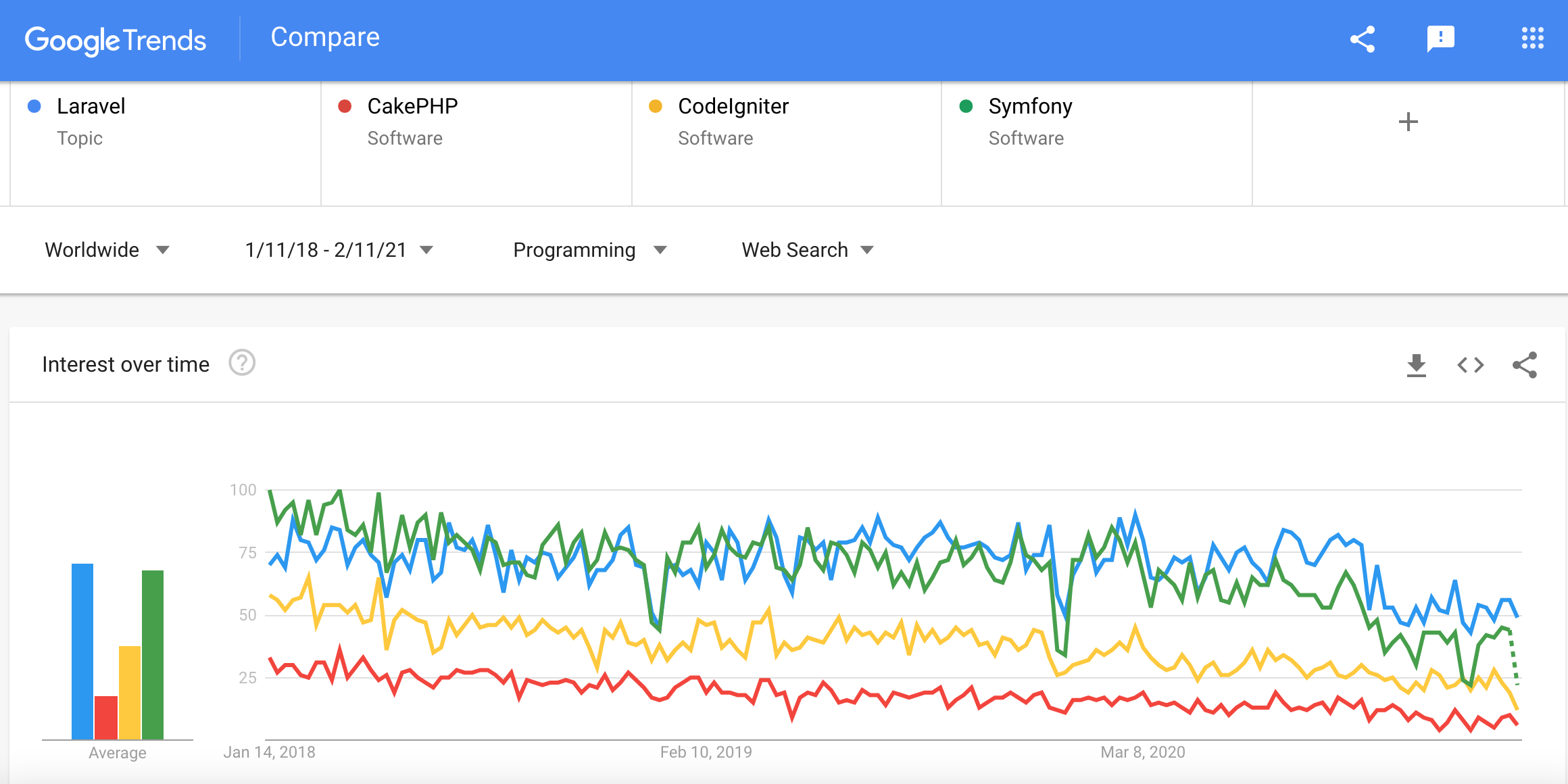7 Reasons PHP Developers Love Using Laravel

A deep understanding of web frameworks, and how to apply them when building software applications, is a fundamental skill for any developer. These are the tools with which modern websites and mobile apps are built. They save time, they’re well-tested for bugs, and keep your code neat and accessible.
If you’re a PHP developer, chances are you’ve worked with Laravel. It’s a full-stack PHP framework that is easy to get started with yet packed full of interesting features. And despite growing competition, many developers clearly still consider it the best PHP framework.
According to a 2020 survey by JetBrains, 50% of PHP developers say they use Laravel regularly, compared to 25% for the next most commonly used framework, Symfony. Data from Google trends also show how Laravel has moved ahead of Symfony and other alternatives in searches. It is used to power the website of some major global brands such as pharma giant Pfizer and the British Broadcasting Company (BBC).

Why is Laravel by many to be the best framework for web development today? Before we dive into the importance of Laravel, it’s worth remembering why PHP script is still so widely used.
As we’ve covered on this blog before, PHP is a popular server-side programming language that emerged in the mid-90s and continues to defy predictions that it is ‘dying’. In fact, W3Techs calculates that just over 79% of all websites use PHP code, a level that has remained fairly constant over the last year. And to put that in perspective, modern PHP’s nearest rival in terms of usage is ASP.NET, but it’s only used in 9.1% of websites today. Newer alternatives like Python get a lot of hype these days but are still only used in a small percentage of websites.
Now let’s examine the main reasons to use Laravel and highlight some of the most important Laravel benefits for your development environment.
1. Simplicity: It´s easy to learn Laravel, and that's a big plus. Developers don’t want to get bogged down in complex, messy code. And businesses definitely don’t want to wait around for their new web application.
Laravel has an expressive and elegant syntax that is simple for even inexperienced programmers. The framework is based on the model-view-controller (MVC) architectural pattern that facilitates the management of complex and large-scale projects. It also offers a wide range of libraries, tools, and templates. This helps developers build stable web applications while maintaining flexibility.
2. Blade and Artisan: Blade is Laravel’s built-in and lightweight template engine, which allows developers to create a web page easily using dynamic content seeding. This tool is highly intuitive and also provides multiple widgets to ensure a web application has a robust and stable structure.
Artisan is Laravel’s powerful built-in command line tool, which helps automate repetitive tasks and manage database migration. It also gives devs the opportunity to create their own custom commands and perform tests in the development environment.
3. Advanced Integrated Features: Laravel also offers intuitive, pre-programmed systems that can be easily added into an application with just a few lines of code. These ‘packages’ can be Laravel-specific or used across PHP frameworks, but are easy to install using Composer.
Laravel Cashier, for example, is a built-in subscription billing feature that handles all the boilerplate code. Socialite is a simplified authentication mechanism for social sites such as Facebook and Google. With a modular framework and an impressive array of packages, developers can easily and seamlessly add functionality to web applications.
4. Security: This is one of the main considerations for any web framework. While none are 100% secure, Laravel has strong credentials. Its in-built CSRF token can handle all kinds of online threats, protecting the web application against the most serious cybersecurity risks (e.g. SQL injection) The framework’s security ecosystem also includes strong community support and tutorials to help developers build water-tight Laravel applications.
5. Testing: Laravel is designed to integrate testing quickly and seamlessly into any web development process. It comes with built-in testing functions and support through PHPUnit. This makes it easy to identify and correct any bugs before they become a costly problem. The system automatically sets the testing environment, but developers can easily define other testing configuration values as necessary.
6. Community & Support: The growing popularity and usage of Laravel over the last decades means that it now has a large and active community of experienced developers able to provide valuable support when required. A developer that reports bugs or security problems is likely to get a quick response from the community, helping to cut down on delays and costs. Laravel also offers numerous screencast tutorials, called ‘Laracasts’, that educate and guide developers.
7. Multi-Lingual: Let’s face it, many web applications are targeting a global market these days. Or at least, have aspirations to expand beyond the local customer base. Laravel includes support for multiple languages so that any website or application can be tailored to different countries.
--
At Jobsity we’re big fans of PHP and Laravel development. In fact, some members of our staff are leaders of the Laravel Community in Latin America. Our developers are PHP certified and know how to maximize the benefits of using Laravel for web development. We’re ready to help your business build an exciting new website or application. All you have to do is get in touch!
If you want to stay up to date with all the new content we publish on our blog, share your email and hit the subscribe button.
Also, feel free to browse through the other sections of the blog where you can find many other amazing articles on: Programming, IT, Outsourcing, and even Management.

With over +16 years of experience in the technology and software industry and +12 of those years at Jobsity, Santi has performed a variety of roles including UX/UI web designer, senior front-end developer, technical project manager, and account manager. Wearing all of these hats has provided him with a wide range of expertise and the ability to manage teams, create solutions, and understand industry needs. At present, he runs the Operations Department at Jobsity, creating a high-level strategy for the company's success and leading a team of more than 400 professionals in their work on major projects.